This
big museum is located in Yokohama which population (3.7 million) is the second
largest after Tokyo. We can understand not only the transition of rulers but
also the one of ordinary people’s lives, so it is suitable to this blog’s theme.
I would like to divide the introduction of this museum into two articles.
横浜市にある大きな博物館です。支配者の変遷だけでなく、庶民の暮らしをたくさん展示しているの素晴らしいです。本ブログのテーマにぴったりな展示品があります。二部に分けて紹介します。
The building was built in 1904 as an HQ of a bank. Bashamichi entrance.
建物は1904年に建てられた元横浜正金銀行本店。馬車道玄関。
The entrance has a particular atmosphere of early 20th century.
エントランスも明治の雰囲気があります
The hallway to the reception: this building is designated as a national important cultural asset.
受付に向かいます。建物自体が国の重要文化財です。
There is a portable shrine in the reception hall. People in Isezaki town carried this and prayed for fire-protection.
正面玄関のホールには伊勢佐木町の「火伏の御神輿」があります
Theme 1: Those who Lived in Ancient Sagami Area【テーマ1】原始・古代「さがみの古代に生きた人びと」
Ancient exhibition room at the 3rd floor、3階の古代展示室
Clay dolls of the Jomon period (more than three thousand years ago) are so winsome.
縄文時代の土偶。愛嬌がある顔です。
Life in the cave at seaside of Miura in the Yayoi period around two thousand years ago.
海辺の海蝕洞窟の暮らし。弥生時代の三浦市にありました。毎日、海を見る生活です。
They didn’t use stones as a knife, they used shells.
石ではなく貝で包丁を作ります
Arrowheads made of shells are beautiful. There are arrowheads made of shark’s teeth, too.
貝の鏃も美しいです。サメの歯で作った鏃もあります。
Accessories in the Kohun period (from 4th century to 7th century) are sophisticated.
古墳時代になるとアクセサリーも洗練されています。
Buildings in the eighth century: people used two kinds of buildings, one was a storage and living space, another was a kitchen. They used clay tableware.
奈良時代になると、庶民の住まいは居住・収納施設である掘立柱(ほったてばしら)建物と厨房施設である縦穴建物で構成されるようになりました(向原遺跡)。下は使われていた土器。
Theme 2: Urban Kamakura and the People of Medieval Times【テーマ2】中世「都市鎌倉と中世びと」
People’s lives which are depicted in a picture roll are exhibited.
一遍上人の絵巻に描かれている庶民の暮らしの展示
Mishima Taisha (shrine): some people pray seriously, and some people enjoy Go-boardgame (lower right).
伊豆三嶋大社への参詣の絵には、下の方に囲碁をしている男女が描かれています
On the second floor, there are exhibition rooms after 17th century.
二階に降りて近世の部屋へ。
Theme 3: The Highways and Popular Culture of Early Modern Times【テーマ3】近世「近世の街道と庶民文化」
First of all, I will show you many Ukiyo-e printings, mainly about Highway (Kaidou) and Post town(Shukuba) .
近世の展示室の最初のコーナーには、「大名は参勤交代の列を組み、庶民は手形を懐に街道を行き交った」とあります。旅の展示が沢山だった。浮世絵を列挙します。
Kawasaki post town、まずは川崎宿
This is also Kawasaki post town created by HiroshigeⅠ.
こちらは、初代広重の川崎。「狂歌入り東海道」と言われるシリーズ。川崎宿の絵は多いです。
Magos, who guide a horse for a traveler, are waiting for customers. They are scruffy but vivid.
客待ちの馬子たち。粗末な身なりだが、イキイキしています。
Beautiful women are major theme of Ukiyo-e printings. Upper left is Kawasaki Taishi (temple). Many printings about Kawasaki, which is the second largest city in this prefecture, are exhibited.
美人画。左上が川崎大師。
Tama River which is between Tokyo and Kanagawa and a ferry passage (Rokugou-no-watashi).
でも、やっぱり川崎は六郷の渡し。
Kanagawa post town in Yokohama city where this museum is.
続いて、神奈川宿
Hodogaya post town: The place, where Hon-kaneko-ya inn was, is a machi-kado (town) museum now (photo below).
保土ケ谷宿:旅籠 本金子屋跡は、まちかど博物館として公開されています
Hodogaya by Hokusai: people in Hokusai’s color printing are really lively if you compare it with other painters.
冨嶽三十六景・東海道程ケ谷(葛飾北斎、天保)。左上は河村岷雪の『百富士』(1767年)から。北斎が画くと人が生きます。
Reference: Sumida Hokusai Museum すみだ北斎美術館
Totsuka post town、戸塚宿
Fujisawa post town、藤沢宿
Hiratsuka: pine trees beside the road remain even until now (below).
平塚:藤沢との間には、今も東海道の松並木が残っています@茅ヶ崎
Oiso post town、大磯宿
Odawara、小田原
Reference: Odawara Local Culture Museum 小田原市郷土文化館
Hakone pass、箱根
There were nine post towns on Tokaidou highway between Kawasaki and Hakone. Tokaidou links Edo and Kyoto, so it is the busiest highway even until now.
神奈川県には、川崎から箱根まで九つの東海道の宿場がありました
Weapons of Hakone check point which was the west end of Kanagawa prefecture、箱根関所の武器
Pilgrimages as pleasure trips、「人びとの楽しみは、信仰と遊山を兼ねた小旅行」
It says, “the pilgrimage
destinations such as Kamakura, Enoshima, Ooyama were good places for easygoing
trips.” Many Ukiyo-e printings are also exhibited here.
次のコーナーは、です。ズバリ楽しみの展示。「金沢八景、鎌倉、江ノ島、大山、箱根などは、気軽な旅の適地となりました」と書かれています。ここにもたくさんの浮世絵が展示されています。
“Kaicyo (Display of treasures of shrines
and temples) map of Edo、江戸開帳地図
Shrines and temples were basically run by the produce from the lands that were donated
by lords. However, when they needed unusual money, they displayed their
treasures or secret Buddha in the big city Edo (old name of Tokyo) as means of
public fundraising.
Those were triggers for Edo people to visit the shrines and temples
in Kanagawa. The events were good for local shrines
and temples, temples in Edo and people in Edo who sought for travel
destinations.
By the way, the governments issued passports soon because those were
religious trips.
鎌倉の鶴岡八幡や妙法寺などが回向院や浅草寺、富岡八幡宮の旧別当寺であった永代寺などで出開帳をしています。
社寺は、寄進された土地の収益で運営していましたが、臨時に多額の費用がかかる時は、尊像や霊宝を大都市に持ち出して公開し、人びとから喜捨を募ったと書かれています。出開帳です。
神奈川では、江戸市中で頻繁に出開帳を催しました。これを契機とし、神奈川の寺社は江戸庶民に知られるようになり、参詣で人びとが訪れるようになったということです。観光展のようなものだったのでしょうか。出開帳をする社寺も、場所を提供する社寺も、参詣者も喜ぶウインウイン関係です。
View of Enoshima island from Kamakura. Enoshima was a popular pilgrimage destination. Now it is one of the most popular locations for marine sports.
鎌倉七里ヶ浜より江ノ島遠見(五風亭貞虎、天保年間)。江ノ島は人気の参拝地です。
Enoshima and Mt. Fuji by Hokusai: he created 36 pictures of Fuji which is called “Fugaku (Mt. Fuji) 36 scenes”.
冨嶽三十六景・相州江ノ島(葛飾北斎、天保初期)
Hiratsuka by Hokusai from “Fugaku 36 scenes”: there is a branch to Ooyama from Tokaidou highway. Ooyama is the other pilgrimage destination. Many people visited Enoshima and Ooyama at the same time.
冨嶽三十六景・相州仲原(葛飾北斎、天保初期):今の平塚辺り。大山への道が通っていました。みんな何かの仕事をしています。
Rouben waterfall at Ooyama by Hokusai (around 1833): pilgrims purified themselves by water.
諸国瀧廻り・相州大山ろうべんの瀧(葛飾北斎、1833年頃):参詣した人の水垢離が有名です
Rouben waterfall at Ooyama by Kuniyoshi Utagawa (1849): many pilgrims went there in summer. In my residence area which is around 80 km away from Ooyama in direct distance, delegates of villages visited there on foot every year after finishing rice planting.
大山良弁(ろうべん)滝之図(歌川国芳、1849):夏(旧暦の6/27~7/17)に多くの人が参詣したと言います。私が住む千葉県北西部からも、田植え後に、毎年、参詣していました。
This is a Sugoroku board game. People roll a dice and put his/her designated piece according to the number shown on it. The starting point is Nihonbashi bridge in Edo and the goal is Ooyama. Tourist spot is depicted on each square such as Enoshima and Kamakura. It is a kind of virtual trip to Ooyama. Players must stay at six post towns, so it is a seven day trip.
新板鎌倉江ノ島大山往来双六/上半分(葛飾北斎、1831年頃):右下の日本橋を出発して、東海道を進み、江ノ島、大山を廻り、矢倉沢往還(国道246号)で日本橋に戻るすごろくです。「泊」のマークが有り、6泊7日の旅だったと書かれています。バーチャル旅行ですね。
Hakone hot spring resort by Hiroshige
箱根七湯図絵・木賀(初代歌川広重、1852)
Hakone by Hokusai from “Fugaku 36 scenes”: Lake Ashinoko and Mt. Fuji
冨嶽三十六景・相州箱根湖水(葛飾北斎、天保初期):箱根の芦ノ湖からは富士山が見えます
Aka (red) Fuji by Hokusai from “Fugaku 36 scenes”: after going over Hakone pass, we can see full view of Mt. Fuji. This is his masterpiece.
冨嶽三十六景・凱風快晴(葛飾北斎、天保初期):箱根を越えれば、富士の全貌が見えます。名作・赤富士。
Travel gears、旅の道具
People carried clothes, a rain coat, medicine, a tobacco case, a lunch box, a towel, a huroshiki folding bag, a lantern, a guidebook and so on.
衣類(脚絆、足袋、下帯、浴衣など)、雨具(菅笠や合羽)、防寒具、薬、煙草入れ、弁当箱、手ぬぐい、風呂敷、提灯、旅行案内書などを携帯したそうです。
Elaborate fake knife to keep silver coins in it
刀に見せかけた財布、銭刀。造りが凝っています
The chic pipe case is a lacquer ware. The lantern is called Odawara chouchin.
粋な煙草入れに小田原提灯
Lunch box case made of bamboo: it is fun to have lunch under the sky.
竹の弁当箱:旅先の弁当は美味いです!
A small medicine box with a cupper cup: I think the owner was proud of this cool gear.
小さな薬籠。金銅製の取手付き湯呑がくくりつけられています。これは、持って楽しい自慢の品でしょう。
Life in feudal villages、「村に生まれ、村に属し、村に暮らした人びと」
Farming in four seasons (copy, 1859): everyone works and it is a cooperative work.
四季耕作図部分(複写、1859年):みんな働いています。基本的に共同作業です。
A copy of a village map in 1825: there are many shrines and road side statues. Natural disasters and plagues struck people back then. Perhaps people prayed for peaceful life every day.
現伊勢原市の上粕屋(かみかすや)の絵図・部分(複製、1825年)。五旗本の相給の集落でした。良く分かる地図で、信仰の施設(■:宮、●:堂、▲:道祖神)が実に多いです。日照り、水害、地震、疫病が頻発した時代でした。無病息災を祈りながら生きてきた感じが伝わります。
Sobu produce taken to Edo、「江戸百万の需要にこたえた相模・武蔵」
People in this area Sobu provided various things to Edo in which one million people lived.
相武の産業を紹介しています。まあ色々なもの、山の幸・海の幸を作っています。
This book introduces how to make a Japanese lacquer which has been made since 17th century in Tsukui.
日本山海名物図絵という本に漆の製法が紹介されています。津久井郡の産物で江戸初期から生産されていたと言います。
This model shows the house of a village head in which people weighed the rice for tax in November. The expressions of farmers are so real. It is Utsumi family in Kamakura.
鎌倉で名主を務めた内海家の年貢計量の様子の模型。11月に母屋前の庭で行ったそうです。伝わってくる模型です。
This is the high-speed ship which gathered fishes from fishing boats at the offshore of Yokohama and brought them to Edo. The ship is depicted on the masterpiece of Hokusai. This ship is called “Oshiokuri bune(ship)”.
押送船(おしおくりぶね)の模型。横浜の沖合で漁船から魚を受け取り江戸に運ぶ高速船です。帆も櫓も使います。北斎の「冨嶽三十六景 神奈川沖浪裏」(画像は、すみだ北斎美術館での写真)に描かれています。
Nine funs(楽fun)were found. Visited in October, 2019
Website: http://ch.kanagawa-museum.jp/english
http://ch.kanagawa-museum.jp/
(much info in Japanese), accessed in July, 2020
Previous post (The first resort hotel in Nikko):
Next post (After
19th century and folklore):
















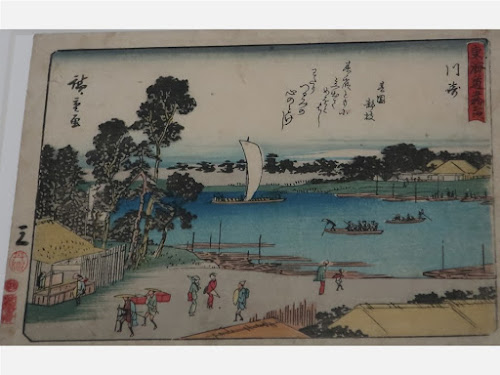
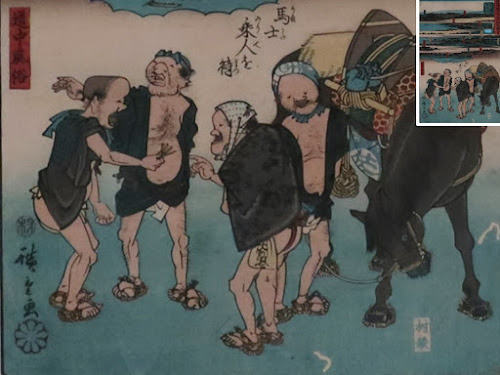



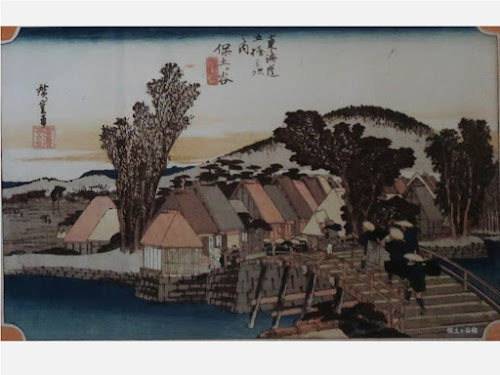






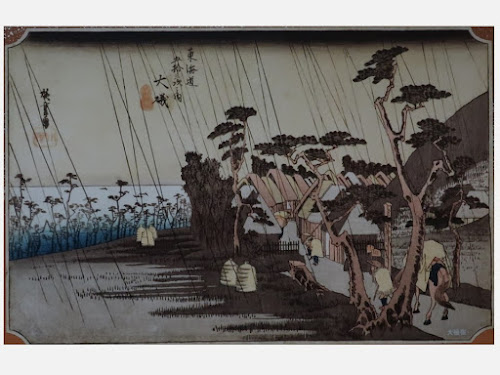














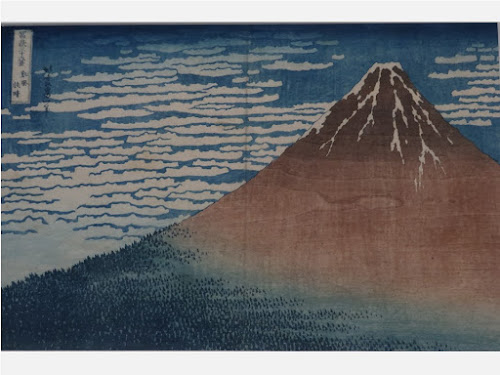











Comments
Post a Comment